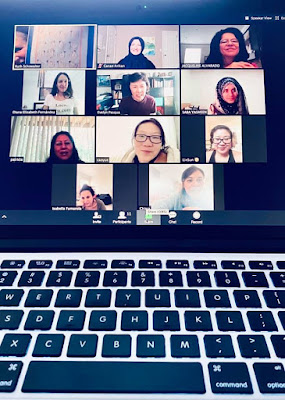Teaching Online: A Rollercoaster Ride to a New Normal
Wait! What? Why am I teaching English language communication online? And, really, is it becoming the new normal? Yes! After teaching almost 200 hours online (150 academic & 50 InterPlay), I can proclaim a resounding Yessssssssssssssss....
It’s the 2020 Pandemic. I’m an educator. I teach international students advanced oral English communications at the Georgia Tech Language Institute (GTLI). Hop on the rollercoaster! Suddenly in the spring, I went from teaching students face-to-face sharing a physical classroom space together to conducting classes with them from my laptop, the etherspace whooshing around us.
That etherspace managed through Bluejeans (Georgia Tech’s online platform for classes) sometimes connected us beautifully. Other times, students suffered broken connections, weak connections, audio filled with static, no video, no audio, and just complete failure to get online or to return once they were dropped. That was the learning curve! It was fast and furious.
Students upgraded their internet services. They discovered which devices worked best for effective online instruction after grappling with smart phones, Ipads, and computers. Some learned to use more than one device simultaneously and to make adjustments for best audio inputs and outputs. We instructors likewise juggled various devices, internet services, and settings in addition to investigating instructional platforms other than Bluejeans. Teams and WebX became possibilities. Wheee!
Within very little time, students became proficient in managing internet breakdowns and online limitations. Some students had returned to their countries such as Korea and Taiwan, and they were managing time zone differences that had them attending classes in the middle of the night! As an instructor, I became confident students would find a solution to whatever problem arose and that they would support my teaching and each other’s learning. Wow!
This rollercoaster ride began in the middle of March. I left the Georgia Tech campus on Thursday, March 12th. We had been warned that we might start sheltering (staying at home) soon, so I brought some instructional books with me and locked up my office. On Friday, we received the news – in-person classes were over for the semester. The following Monday, my colleagues and I received training about how to teach online. We leapt onto our computers the next day to greet our students and begin the adjustment to the “new normal” of online language instruction. Woohoo!
 |
| Academic Presentations for Visiting Scholars. In April, I began teaching 18 hours of presentation skills for GT researchers from India, South Korea, Japan, China, and Chile. |
Since that first fateful day in March when I greeted students as they peered out at me from the grid on the cool medium of a computer screen, I have logged in teaching almost 200 instructional hours online: 150 for English language instruction and close to 50 hours of InterPlay workshops.
For me, this online instruction is the new normal.
 |
| Again, The New Normal - Cat Companionship. I inhabit the cat terrain in our household. Therefore, they accept my presence and I humbly accept theirs. |
On August 17th, my fall classes at the GTLI begin. We are meeting mostly “remotely” with proposed “touch points.” This kind of instruction has been given a name – “hybrid.” The remote teaching is online and can be conducted either synchronously or asynchronously. As an educator who believes in “embodied” or kinesthetic learning, I will be teaching all of my online classes synchronously or “live.” However, there will be an asynchronous aspect because I need to record my classes for students unable to attend. We are making allowances for time differences, poor internet connections, life disruptions in personal spaces, and technical breakdowns.
A “touch point” is being seen as a way of bringing students together safely in a physical space to have a meaningful social experience. Each of us lecturers is looking for ways to provide this in person opportunity for our students. Stay tuned for my epiphany. I’m waiting for a “pop” of an idea how to create meaningful face-to-face instruction for my students that will be safe and move their learning forward. Any suggestions?
For the time being, I feel fortunate that I have the tools and know-how to educate my students online. For now, teaching from a computer in my home is the new normal. The rollercoaster ride is over. The experience has become more like a routine workout at the gym. Often you don’t want to go there, but always feel great when you’re finished.






Comments
Post a Comment